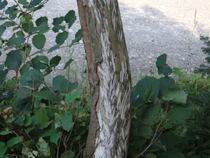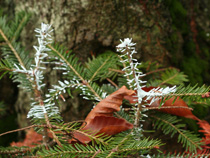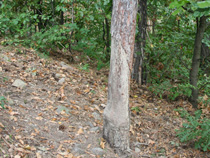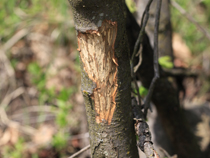Animals
Animals and game belong to the serious pests of trees and shrubs. Bark stripping from main stems, branches, and side shoot stripping game prevent growth and can cause the death of woody plants.
Root damage
• Wild boars are digging seedlings and ripping the soil with natural seeding.
• The root buttress of older trees can be damaged by abrasion, especially by wild boars.
The trunk and branches damage
• The bark stripping damages tree trunks are caused by red deer, roe deer, and fallow deer. They damage and feed on the bark, bast, and sapwood of trees, focusing on the lower part of the trunk, usually without branches, to a height of 2 meters.
• Deer damages the trunks by stripping. Stripping is caused by the peeling off pieces of bark with bast during the period of sap flow. The game bites the bark and peels it off by shaking its head, leaving a sapwood layer on the trunk. When peeling, the game damages and consumes the bark of the trunks without damaging the branches.
• Roe deer, red deer, and fallow deer damage the trunks by fraying. The trunks are stripped of bark and bast up to the sapwood; the branches are considerably damaged and broken. Pieces of damaged bark and bast often hang at the site of trunk damage.
• In the southern areas of Slovakia, hares and rabbits can damage the bark of shoots and trunks by stripping. Traces of rodents are shallowly engraved in sapwood and are about 7-9 mm wide.
Bark stripping
Game species: Red deer, roe deer, fallow deer, mouflon, and European hare
Time of damage occurrence: Winter period, mainly the end - February - April.
Description of damage: The game damages and consumes the bark, bast, and sapwood of trees by stripping. On the tree's trunk at the height of approximately 1.5 - 2 meters, there are clear traces of gnaws in the bast or sapwood part. A stripping can damage a part of the trunk girth, resulting in the physiological weakening of the damaged individual. In addition, fungal diseases can attack the tree as a secondary pest in the wound place. The availability of further secondary damages increases, and if the tree survives, the trunk quality is permanently reduced. If a bark stripping damages the entire circumference of the trunk, the conductive tissues are interrupted, and the damaged tree dies. In the spring (April - June) - the period of sap flow, the game also damages the trunk by peeling. It peels 50 to 100-centimeter strips of bark on trunks to a height of approximately 2 m. The sapwood layer remains exposed. The branches are not damaged.
Possibility of damage confusion: In the case of bark stripping by red deer, the width of the gnaws trace is 0.5 to 0.7 cm, and in the case of roe deer, it is 0.2 to 0.3 cm. The stripping caused by a hare on thinner trunks and seedlings is characterized by 0.7 - 0.9 cm sharp traces of rodents in the sapwood part. The damage is similar to fraying, but the branches are not damaged. Bark stripping can also be confused with mechanical damage caused by thinning, cleaning, or cutting.
The most frequently damaged woody plants: Norway spruce Picea abies (L.) Karst., ash Fraxinus spp., mountain ash Sorbus spp., European beech Fagus sylvatica L., oak Quercus spp., pine Pinus spp., goat willow tree Salix caprea L.
Endangered stands and areas: Spruce monocultures aged 20-60 and other trees aged 30. Area damage to vegetation is typical.
Abrasion
Game species: Wild boar, less roe deer, fallow deer, and mouflon.
Time of damage occurrence: The damage occurs at any time of the year, less in winter.
The most frequently damaged woody plants: Most woody plants favored are woody plants with rough bark: oak Quercus spp., pine Pinus spp., and birch Betula spp.
Endangered stands: Older stands near the pools that the game visits. Damage occurs locally in stands, often on individual trees.
Description of the damage: Near the pools, the game rubs against the trunks of surrounding trees, thus getting rid of parasites in its fur. Using the same trunks for many years, the bark and bast is ripened to the sapwood, with a subsequent disposition for secondary damage, especially by fungal pests. During multi-year abrasion, the bark and bast are removed up to the sapwood and calluses forms.
Possibility of damage confusion: In the case of wild boars up to a height of 1 m, in the case of deer up to a height of 1.5 m, there are evident remains of fresh and dried mud, often with pieces of fur. The hair in the wound usually clearly distinguishes this type of damage from other mechanical damage (e.g., damage caused by skidding wood out of the forest).
Browsing
Game species: Rot deer, roe deer, fallow deer, mouflon game, and European hare.
Time of damage occurrence: The most severe damage occurs during the winter period from November to March.
Description of damage: Young annual shoots are damaged and subsequently consumed by browsing, or only the end parts on older trees. During the summer browsing, the leaves are consumed along with the annual shoots, and during the winter browsing, which is more harmful, the game consumes buds and needles. The side twigs are damaged, as well as the terminal part of the tree. Repeated intense browsing associated with damage to the top of the tree leads to a significant slowdown in growth or even death of the tree. Browsing is especially harmful to seedlings. Repeated intensive browsing slows the growth, forming conical - pyramidal tree shapes.
Possibility of damage confusion: Red deer, roe deer, fallow deer, and mouflon do not have gnaws in the upper jaw, so they tear off the twig, which is reflected in the uneven, torn edge. Some twigs in the higher parts of the tree are bent with gnawed end parts. The hare has rodents in the lower and upper jaw, biting the twig. A smooth, slightly sloping surface characterizes the feed mark. Sometimes the hare bites and gnaws a thicker twig. The browsing can be confused with another type of mechanical damage. The same damage, especially to young trees, is caused by grazing cattle.
The most commonly damaged woody plants: silver fir Abies alba Mill., Norway spruce Picea abies L., pine Pinus spp., European larch Larix decidua Mill., European beech Fagus sylvatica L., oak Quercus spp., linden Tilia spp., maple Acer spp., ash Fraxinus spp., and other woody plants.
Endangered stands and areas: Seedlings, young plantations up to a height of 1.5 to 2 meters.
 |
 |
 |
 |
|
Trunk damaged by bark stripping. Photo: M. Zúbrik |
Various types of paints are used as protection against the game. Photo: M. Zúbrik |
Trunk damaged by abrasion. Photo: M. Zúbrik | Trunk damage. Foto: M. Zúbrik |



